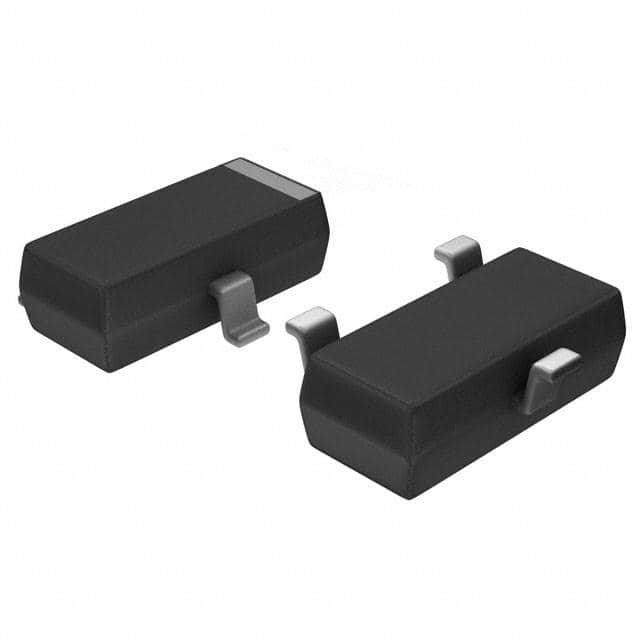Viz Specifikace pro podrobnosti o produktu.

ADM809MART-REEL7
Product Overview
Category
ADM809MART-REEL7 belongs to the category of integrated circuits (ICs).
Use
This product is commonly used in electronic devices for voltage monitoring and reset functions.
Characteristics
- Voltage monitoring and reset functionality
- Low power consumption
- Wide operating voltage range
- Small package size
- High accuracy
Package
ADM809MART-REEL7 is available in a small surface-mount SOT-23 package.
Essence
The essence of this product lies in its ability to monitor the voltage level of a system and provide a reset signal when the voltage falls below a certain threshold.
Packaging/Quantity
ADM809MART-REEL7 is typically packaged in reels containing a specified quantity of units, usually 3000 pieces per reel.
Specifications
- Supply Voltage Range: 1.2V to 5.5V
- Reset Threshold Voltage Options: 2.63V, 2.93V, 3.08V, 4.38V
- Reset Timeout Period: 140ms (typical)
- Quiescent Current: 6µA (typical)
- Operating Temperature Range: -40°C to +85°C
Detailed Pin Configuration
ADM809MART-REEL7 has three pins:
- VCC: Power supply input pin.
- GND: Ground reference pin.
- RESET: Output pin for the reset signal.
Functional Features
- Voltage Monitoring: ADM809MART-REEL7 continuously monitors the supply voltage.
- Reset Generation: When the supply voltage drops below the set threshold, the device generates a reset signal.
- Reset Timeout: The reset signal remains active for a specific timeout period after the voltage rises above the threshold.
Advantages and Disadvantages
Advantages
- Reliable voltage monitoring and reset functionality.
- Low power consumption, suitable for battery-powered devices.
- Wide operating voltage range allows compatibility with various systems.
- Small package size enables space-saving designs.
- High accuracy ensures precise voltage monitoring.
Disadvantages
- Limited reset threshold voltage options may not cover all application requirements.
- Reset timeout period is fixed and cannot be adjusted.
Working Principles
ADM809MART-REEL7 operates by comparing the supply voltage with the set threshold voltage. When the supply voltage falls below the threshold, the device triggers a reset signal. The reset signal remains active for a specific timeout period after the voltage rises above the threshold, ensuring a stable system restart.
Detailed Application Field Plans
ADM809MART-REEL7 finds applications in various electronic devices where voltage monitoring and reset functionality are crucial. Some common application fields include:
- Microcontrollers: Ensures reliable system reset during power fluctuations.
- Embedded Systems: Provides voltage supervision to prevent data corruption.
- Industrial Control Systems: Monitors power supply integrity for critical equipment.
- Automotive Electronics: Protects sensitive components from voltage drops.
- Consumer Electronics: Enables safe power-on reset for devices like smartphones and tablets.
Detailed and Complete Alternative Models
- ADM803/ADM809 Series: Similar voltage monitoring and reset ICs with different package options.
- MAX809/MAX810 Series: Alternative ICs offering comparable features and performance.
- MCP1316/MCP1317 Series: Voltage supervisors with additional features like manual reset input.
In conclusion, ADM809MART-REEL7 is an integrated circuit that provides voltage monitoring and reset functionality. It offers advantages such as low power consumption, wide operating voltage range, and high accuracy. Its small package size makes it suitable for space-constrained designs. However, it has limited reset threshold voltage options and a fixed reset timeout period. This IC finds applications in various electronic devices across different industries. Alternative models like ADM803, MAX809, and MCP1316 can be considered based on specific requirements.
Seznam 10 běžných otázek a odpovědí souvisejících s aplikací ADM809MART-REEL7 v technických řešeních
Sure! Here are 10 common questions and answers related to the application of ADM809MART-REEL7 in technical solutions:
Q: What is the purpose of ADM809MART-REEL7? A: ADM809MART-REEL7 is a voltage supervisor IC that monitors the power supply voltage and generates a reset signal when the voltage falls below a specified threshold.
Q: What is the operating voltage range of ADM809MART-REEL7? A: The operating voltage range of ADM809MART-REEL7 is typically between 1.1V and 4.63V.
Q: How does ADM809MART-REEL7 generate a reset signal? A: ADM809MART-REEL7 uses an internal comparator to monitor the voltage level. When the voltage drops below the threshold, it pulls the reset output low.
Q: Can ADM809MART-REEL7 be used with both microcontrollers and digital logic circuits? A: Yes, ADM809MART-REEL7 can be used with both microcontrollers and digital logic circuits as long as the operating voltage is within the specified range.
Q: What is the typical reset timeout period of ADM809MART-REEL7? A: The typical reset timeout period of ADM809MART-REEL7 is 140ms.
Q: Is ADM809MART-REEL7 available in different package options? A: Yes, ADM809MART-REEL7 is available in various package options such as SOT-23, SC-70, and TSOT-23.
Q: Can ADM809MART-REEL7 tolerate voltage spikes or transients? A: Yes, ADM809MART-REEL7 has built-in glitch immunity and can tolerate voltage spikes or transients up to 200mV.
Q: What is the typical quiescent current consumption of ADM809MART-REEL7? A: The typical quiescent current consumption of ADM809MART-REEL7 is 5µA.
Q: Can ADM809MART-REEL7 be used in battery-powered applications? A: Yes, ADM809MART-REEL7 is suitable for battery-powered applications due to its low quiescent current consumption.
Q: Does ADM809MART-REEL7 have an open-drain or push-pull reset output? A: ADM809MART-REEL7 has an open-drain reset output, which allows for flexibility in connecting multiple devices to a common reset line.
Please note that these answers are general and may vary depending on the specific datasheet and application requirements.

